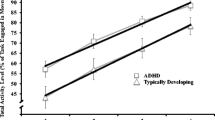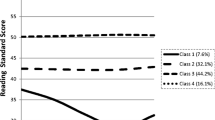Abstract
Mixed hyperactive/reading-disabled children, selected from a large sample of hyperactive children, were compared to pure hyperactive children on demographic, behavioral, and neuropsychological measures. Children in the Mixed group were reading-disabled relative to age and IQ; those in the Pure group had achievement scores that were average relative to age and IQ. The Mixed group was significantly older than the Pure group; there were no differences in gender, race, or socioeconomic status. Behaviorally, the groups did not differ significantly on teacher ratings or on psychiatric ratings of aggression. The Mixed group had a significantly higher Performance IQ, whereas the Pure group had a significantly higher Verbal IQ and performed better on measures of cognitive impulsivity. Several other measures failed to distinguish the groups. The data give minimal support to the notion that pure hyperactive and mixed hyperative/reading-disabled children constitute distinct subgroups of Attention Deficit Disorder with Hyperactivity.
Similar content being viewed by others
References
Ackerman, P. T., Dykman, R. A., Holcomb, P. J., & McCray, D. S. (1982). Methylphenidate effects on cognitive style and reaction time in four groups of children.Psychiatry Research, 7, 199–213.
Ackerman, P. T., Dykman, R. A., & Peters, J. E. (1976). Hierarchical factor patterns on the WISC as related to areas of learning deficit.Perceptual and Motor Skills, 43, 583–615.
Allen, T. W. (1975). Patterns of attention to temporal stimulus sequences and their relationship to reading achievement.Child Development, 46, 1031–1038.
Bakker, D. J. (1967). Temporal order, meaningfulness, and reading ability.Perceptual and Motor Skills, 24 1027–1030.
Beery, K. E. (1967).Developmental test of visual-motor integration. Chicago: Follett.
Belmont, L., & Birch, H. G. (1966). The intellectual profile of retarded readers.Perceptual and Motor Skills, 22, 787–816.
Cantwell, D. P., & Satterfield, J. H. (1978). The prevalence of academic underachievement in hyperactive children.Journal of Pediatric Psychology, 3, 161–171.
Cone, T. E., & Wilson, L. R. (1981). Quantifying a severe discrepancy: A critical analysis.Learning Disability Quarterly, 4, 359–371.
Conners, C. K. (1969). A teacher rating scale for use in drug studies with children.American Journal of Psychiatry, 126, 884–888.
Denckla, M. B., Rudel, R. G., & Broman, M. (1980). The development of spatial orientation skills in normal, learning-disabled and neurologically impaired children. In D. Caplan D. Caplan (Ed.),Biological studies of mental processes (p. 44–59). Cambridge: M.I.T. Press.
Gittelman, R., Abikoff, H., Pollack, E., Klein, D. F., Katz, S., & Mattes, J. (1980). A controlled trial of behavior modification and methylphenidate in hyperactive children. In C. Whalen & B. Henker (Eds.),Hyperactive children: The social ecology of identification and treatment (pp. 221–243) New York: Academic Press.
Gittelman-Klein, R., Klein, D. F., Katz, S., Saraf, K., & Pollack, E. (1976). Comparative effects of methylphenidate and thioridazine in hyperkinetic children.Archives of General Psychiatry, 33, 1217–1231.
Hollingshead, A. B., & Redlich, F. C. (1958).Social class and mental illness. New York: Wiley.
Jastak, J. F., & Jastak, S. R. (1978).The Wide Range Achievement Test. Wilmington: Jastak Associates.
Keogh, B. K. (1971). Hyperactivity and learning disorders: Review and speculation. Exceptional Children,38, 101–110.
Kirk, S. A., McCarthy, J. J., & Kirk, W. D. (1968).Illinois Test of Psycholinguistic Abilities. Urbana: University of Illinois Press.
Lambert, N. M., & Sandoval, J. (1980). The prevalence of learning disabilities in a sample of children considered hyperactive.Journal of Abnormal Child Psychology, 8, 33–50.
Loney, J., & Milich, R. (1981). Hyperactivity, inattention, and aggression in clinical practice. In M. Wolraich & D. K. Routh (Eds.),Advances in behavioral pediatrics (Vol. 2). Greenwich: JAI Press.
Milich, R., & Loney, J. (1979). The role of hyperactive and aggressive symptomatology in predicting adolescent outcome among hyperactive children.Journal of Pediatric Psychology, 4, 93–112.
Owen, F. W., Adaras, P. A., Forrest, T., Stolz, L. M., & Fisher, S. (1971). Learning disorders in children: Sibling studies.Monographs of the Society for Research in Child Development, 36 (Serial No. 144, 1–77).
Reynolds, C. R. (1981). The fallacy of “two years below grade level for age” as a diagnostic criterion for reading disorders.Journal of School Psychology, 19, 350–358.
Routh, D. K. (1980). Developmental and social aspects of hyperactivity. In C. R. Whalen & B. Henker (Eds.),Hyperactive children: The social ecology of indentification and treatment. (pp. 55–73). New York: Academic Press.
Rutter, M., & Yule, W. (1975). The concept of specific reading retardation.Journal of Child Psychology and Psychiatry, 16, 181–197.
Schachar, R., Rutter, M., & Smith, A. (1981). The characteristics of situationally and pervasively hyperactive children: Implications for syndrome definition.Journal of Child Psychology and Psychiatry.22, 375–392.
Stewart, M. A., Cummings, C., Singer, S., & DeBlois, C. S. (1981). The overlap between hyperactive and unsocialized aggressive children.Journal of Child Psychology and Psychiatry, 22, 35–45.
Stewart, M. A., DeBlois, C. S., & Cummings, C. (1980). Psychiatric disorder in the parents of hyperactive boys and those with conduct disorder.Journal of Child Psychology and Psychiatry, 21, 283–292.
Sturge, C. (1982). Reading retardation and antisocial behaviour.Journal of Child Psychology and Psychiatry, 23, 21–31.
Symmes, J. S., & Rapoport, J. L. (1972). Unexpected reading failure.American Journal of Orthopsychiatry, 42, 82–91.
Warrington, E. R. (1967). The incidence of verbal disability associated with retardation reading.Neuropsychologia, 5, 175–179.
Author information
Authors and Affiliations
Additional information
This research was supported in part by Mental Health Clinical Research Grant MH-30906 and by U. S. Public Health Service Grant MH-18579.
Rights and permissions
About this article
Cite this article
Halperin, J.M., Gittelman, R., Klein, D.F. et al. Reading-disabled hyperactive children: A distinct subgroup of Attention Deficit Disorder with Hyperactivity?. J Abnorm Child Psychol 12, 1–14 (1984). https://doi.org/10.1007/BF00913458
Revised:
Issue Date:
DOI: https://doi.org/10.1007/BF00913458




